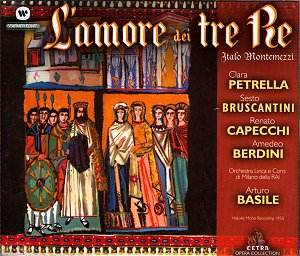 Composer: Italo Montemezzi
Composer: Italo Montemezzi
Works: L’amore dei tre re
Performers: Sesto Bruscantini (bass), Clara Petrella (soprano), Amedeo Berdini (tenor), Renato Capecchi (baritone), Aldo Bertucci (tenor), Gilda Capozzi (soprano), Ebe Ticozzi (contralto), Orchestra Lirica e Coro di Milano della RAI, Arturo Basile (conductor)
Recording: Mono, Milan, 3 September 1950
Label: Warner Fonit
Italo Montemezzi’s L’amore dei tre re has long occupied a curious position within the pantheon of early 20th-century operatic works. Launched into the world at La Scala in 1913, it was heralded by some as the quintessential successor to Verdi’s tragic legacy, a claim that resonates with particular fervor in American opera houses where it found a more enduring welcome than in its native Italy. The opera, sculpted from Sem Benelli’s libretto, embodies a tapestry of intense emotional and psychological conflict, set against a backdrop of medieval intrigue and familial betrayal. Yet, while it may not have achieved the canonical status of its predecessors, its rich orchestration and dramatic narrative are worthy of renewed exploration, as evidenced by this recent recording.
The performances captured in this Warner Fonit release are commendable, with Sesto Bruscantini emerging as the clear standout. His portrayal of the blind baron Archibaldo is both chilling and authoritative, encapsulating the character’s potent mixture of vulnerability and menace. Bruscantini’s vocal technique, marked by a rapid vibrato, occasionally veers towards the old-fashioned, yet this very quality imbues his singing with an emotional weight that serves the character’s tragic arc. Each of his appearances is marked by a poignant gravity, and he remains the emotional anchor through the opera’s tumultuous narrative. Clara Petrella, as Fiora, and Amedeo Berdini, as Avito, offer commendable performances, their youthful ardor and vocal lines weaving beautifully together, particularly in the lush duet of the second act. However, Renato Capecchi’s Manfredo, despite the role’s inherently limited presence in the first two acts, struggles to leave a lasting impression, with his characterization developing only in the opera’s later stages.
Conductor Arturo Basile leads the Orchestra Lirica e Coro di Milano with a deft hand, capturing the work’s oscillation between languid lyricism and dramatic fervor. The orchestration, while occasionally dense, reveals traces of both Wagnerian influence and the impressionistic textures found in Debussy’s Pelléas et Mélisande. This duality is particularly evident in the orchestral interludes that accompany the more intimate moments of the score, where Montemezzi’s lush harmonic language flourishes. Yet, the recording’s mono sound quality presents challenges; the timpanist’s contribution, for instance, has a dull resonance, reminiscent of artillery fire rather than the rhythmic pulse intended. Despite these limitations, one soon acclimates to the sonic environment, and by the time Fiora meets her tragic fate, the immersive quality of the drama prevails.
While the historical context of L’amore dei tre re cannot be overlooked, its contemporary interpretations invite a re-evaluation. It is a work that has been somewhat overshadowed by its more illustrious contemporaries, yet the emotional depth and dramatic stakes it presents merit more than a cursory listen. The opera’s exploration of love, jealousy, and the tragic consequences of human folly resonates across time, and the performances on this recording illuminate its potential.
This recording serves as a noteworthy exploration of Montemezzi’s operatic landscape, with Bruscantini’s transcendent performance as a pivotal reason to revisit this oft-overlooked work. The blend of dramatic intensity and lyrical beauty speaks to the opera’s enduring, if somewhat elusive, appeal. For those willing to embrace its historical curiosities, L’amore dei tre re reveals itself as a compelling testament to the complexities of love and loss, solidifying its place in the concerted efforts to revive and reassess the Italian operatic canon of the early 20th century.



